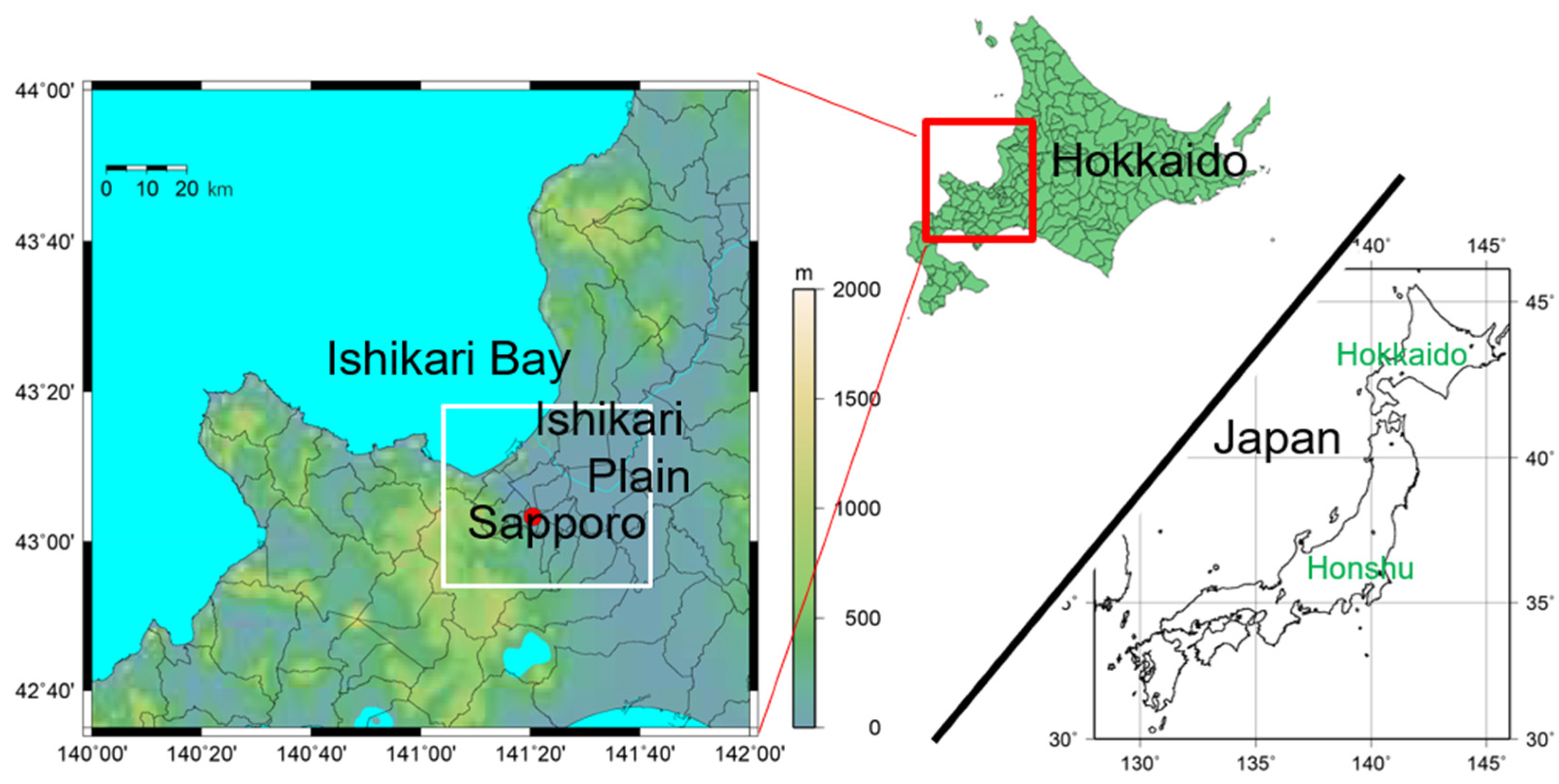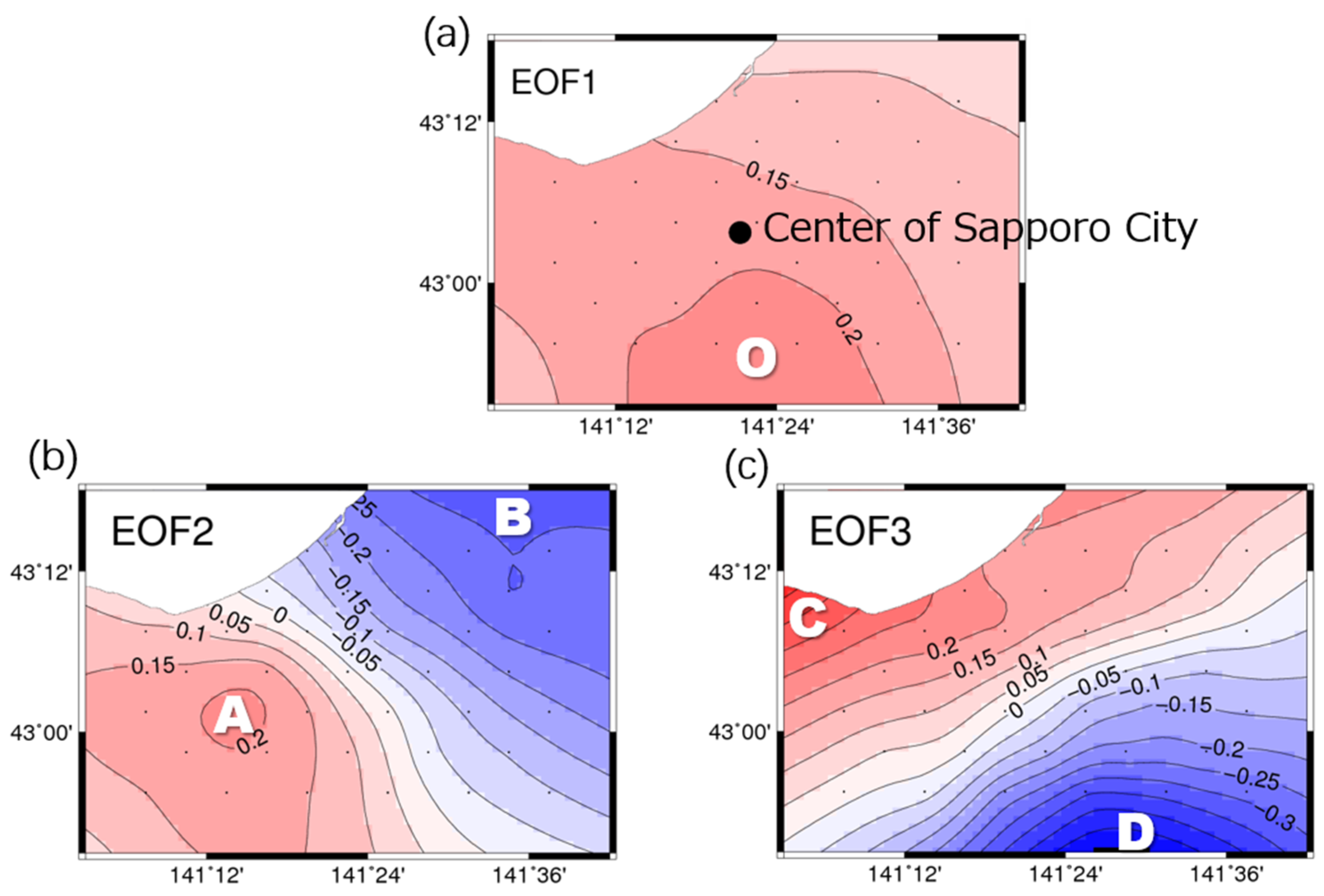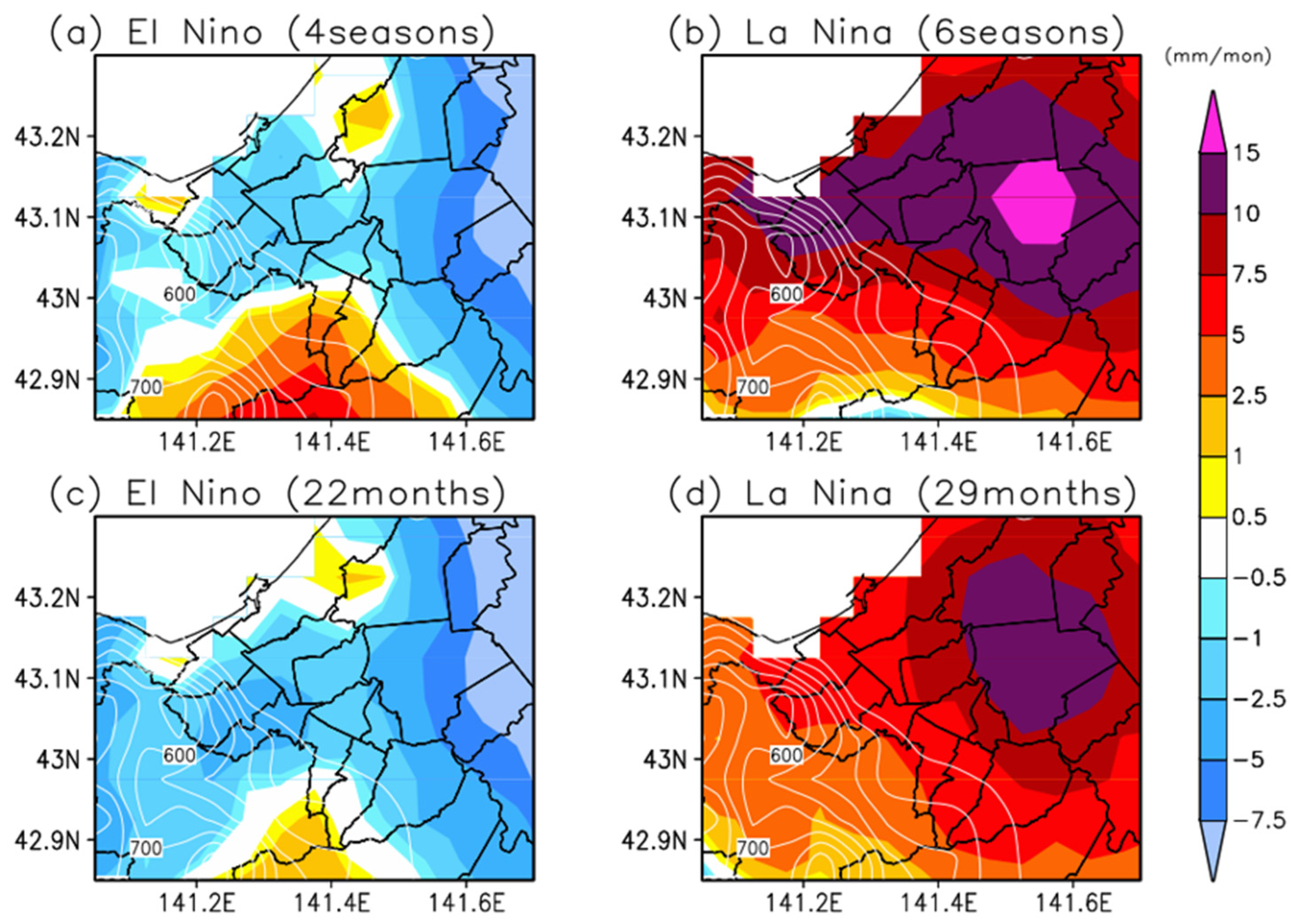1. Introduction
There are growing concerns that global warming increases the amount of water vapor in the atmosphere, which will increase the amount of precipitation [
1]. In addition, local environmental changes due to global warming have been studied in global climate model experiments, e.g., the Climate Model Intercomparison Project [
2]; however, these climate model investigations have not reproduced the local precipitation distribution corresponding to the global signal, climate index, and teleconnection (e.g., [
3]). Thus, it is important to investigate the relationship between the global signal and local precipitation after quantitative evaluation in terms of seasonal prediction. It contributes understanding and forecasting future mountain snow and ice water resources [
4], and adaptation to global warming and climate change.
The Honshu Island of Japan Sea side of Japan (
Figure 1) is known worldwide for its heavy snowfall due to the winter monsoon (
Figure 2a). Although there have long been studies on mountain/plain snow along the coast [
5,
6], synoptic scale weather impact to them [
6,
7], Japan convergence zone (JPCZ) [
8], and mountain effects to local precipitation [
9], there are few studies on long-term variations of snowfall, including those in Hokkaido. One reason for less studies may be the difficulty of snowfall observation.
Since several decades ago, studies of global- or continental-scale climate signals and regional precipitation have been conducted at various spatial and temporal scales; however, the study of the relationship between water resources and the climate index has been limited due to limited precipitation data for mountainous regions. Thus, we collected as much rain-gauge data as possible to create a quantitative grid precipitation dataset over Asia including Japan [
10,
11]. As these APHRODITE papers show, better climatology can be used for high-resolution model validation including mountainous regions such as the Himalayas [
12]. Furthermore, by collecting and including daily precipitation data, these gridded data made it possible to meteorological/monsoonal analysis over the mountainous regions (Yatagai et al., 2012 [
11], Figure 7). On the other hand, although the Japan Meteorological Agency (JMA) AMeDAS is a dense-network of rain gauges (1300 stations~), the additional data other than JMA stations have enabled a more quantitative study of the disastrous heavy precipitation including mountainous regions [
13].
The Sapporo City region, which is located on the Sea of Japan side of Hokkaido, experiences heavy snowfall. In this region, plains extend from north to east, and mountains are found to the west (
Figure 1). Sapporo is located in the northwest area of the Ishikari Plain (see
Figure 1). In terms of winter precipitation amount, Sapporo has less than the other cities on the Japan Sea side of Honshu, but with a population of about 1.9 million (2022), Sapporo can be a considered the largest city on the Sea of Japan side. Therefore, the distribution of snow in winter has a significant impact on the lives of citizens [
14,
15]. In this regard, Sapporo city has its own precipitation observations for road snow removal purposes (
Figure 3a). By adding these observations, it would be possible to produce a correspondence with synoptic and large-scale conditions to determine which areas receive more snowfall as a winter season prediction.
Figure 2b shows the average daily precipitation for Sapporo during December–March. This is the average precipitation amount obtained through this study. Precipitation is heavy in the mountainous areas distributed in the southwest, and is also heavy in the northeast. The largest standard deviations (SD) of daily precipitation variability are found in the southwestern mountainous region. Using this network data is expected to contribute to reveal regional snowfall patterns and its interannual variability.
Therefore, this study attempts to clarify the regional characteristics of precipitation distribution over Sapporo by adding the local (Sapporo city) precipitation data to AMeDAS stations and creating daily grid precipitation data that expresses orographic effects. Then, use the data to investigate the relationship between local precipitation distribution and synoptic weather, and their interannual variations in winter.
As a precipitation variation over Sapporo, Tachibana (1995) [
16] investigated the synoptic and meso-scale statistics of precipitation around Sapporo by applying rotated empirical orthogonal function analysis of precipitation over western Hokkaido. Tachibana explained that snowfall along the coast of Ishikari Plain (see
Figure 1) is due to the convergence of katabatic winds on the Hokkaido scale and northwesterly monsoon.
Recently, Farukh and Yamada [
15] discussed synoptic-scale atmospheric circulation patterns that are associated with extreme heavy snowfall in Sapporo City. Heavy snowfalls frequently cause traffic problems in Sapporo City. In fact, they have shown the topmost snowfall events were triggered by the advection of very cold airmass from eastern Siberia, anomalously huge moisture with northerly strong wind, active and stationary Aleutian low, and 500 hPa deep cold-core low over the southern Hokkaido. However, sub-regional (i.e., within Sapporo City) precipitation distribution has not been discussed yet.
Although Japan’s winter season is considered to be warm with light snow in the El Niño case [
17,
18], the relationship with the global signal is expected to be complex [
3] due to the effects of winter monsoon intensity, water vapor transport processes, local mountain and valley winds, and sea-land winds. Hence, Sapporo is considered to be one of the best test fields to investigate the impact of El Niño/Southern Oscillation (ENSO) to local snowfall, if quantitative grid precipitation data are created.
The goal of this study was to understand how global signals, e.g., El Niño and La Niña, affect the regional distribution of snowfall in the Sapporo region. However, to do this, reliable data are necessary. Hence, the purpose of the study is (1) to make a daily gridded precipitation dataset by the APHRO_JP method by adding Sapporo Multi-Sensor network data, (2) to analyze regional differences in winter daily precipitation around Sapporo to determine the occurrence of characteristic heavy snow patterns and (3) investigate the relationship of (2) with ENSO.
4. Discussion
Based on the daily precipitation grid data over Sapporo, we clarified the relationship between regional winter precipitation distribution, dominant synoptic weather patterns, and their interannual variability. When the winter pattern is weak, precipitation tends to be brought to the mountain and inland regions of southwestern Sapporo (A and D). In contrast, when the winter pattern is strong, precipitation is more likely to occur in the seaward side and plain regions in the target area (B and C).
The purpose of this study was to look at the variability of horizontal precipitation distribution within the Sapporo area, but we also examined EOF1, which represents global precipitation. The high precipitation winter and frequency of occurrence of EOF1 > 1 did not agree with Farukh and Yamada [
15]. In their 19 winter seasons, extreme snowfall days were found in 1999/2000, 2003/2004, and 1998/1999. Appearance of EOF1 > 1 was higher in all three years in our analysis, but top-3 was 2005, 1996, and 2013. This may be due to differences in the winter target months and in the data processing, even though the original MSS data handled were the same. They also indicate that the topmost one to six seasons appeared in the positive values of the Southern Oscillation Index (SOI). Although the indices used are different, this is consistent with our general observation in
Figure 14 that there is more precipitation in La Niña and less precipitation in El Niño except in the southern part of the country. However, detailed comparisons will be made in the future, since the indices and months/years are somewhat different.
The occurrence of A, B, C, and D with respect to EOF1 > 1 and mean precipitation was also examined. It is found that type B (northeast plain precipitation) contributes more when EOF1 < 1 and areal precipitation is high. The type B is the one most likely to appear prominently in La Niña among the four types. As the result, we also showed more snow fell in the southwestern mountains and inland areas during El Niño winters (
Figure 14b); on the contrary, we found that more snow fell in the northeastern plains and along the sea during La Niña winters (
Figure 10). As for the difference in El Niño (4 years) or La Niña (6 years) average precipitation, seasonal precipitation anomaly was not significant. However, the appearance of the regional precipitation type seems to have physical meaning since their signal showed consistency with synoptic scale atmospheric circulation (SLP, 850 hPa wind). In addition, these results comply well with the fact that El Niño winters have weak winter patterns [
4].
The relationship between the regional precipitation distribution and ENSO shown in
Figure 9,
Figure 12 and
Figure 14 is very interesting: with the exception of 1998, types A,D appeared more frequently in El Niño, and precipitation was more in the mountains and inland areas of the Sapporo, and B,C appeared more frequently in La Niña and precipitation was more along the coast and in the plains. The winter period of 1997/1998 is known as a “super” El Niño [
20]. This study has clarified that, with the exception of super-El Niño conditions, more precipitation falls in the mountain and inland regions during El Niño winters, and more precipitation is observed in the plains and seaward areas during La Niña periods. Note that the response of the Super El Niño to the winter monsoon in Japan is beyond the scope of this paper.
Regarding the relationship between winter pattern and Japanese winter snowfall, when a winter pattern is strong, i.e., high in the west and low in the east, more snow occurs in the mountains of Niigata Prefecture (approximately 500 km south of Sapporo) [
5]. At first glance, Akiyama [
5] and our study seem to contradict each other. However, this is due to the difference in the direction and position of the mountains relative to the winter monsoon between Niigata and Sapporo, and neither is incorrect. Analysis of western Hokkaido (Tachibana, 1995 [
16]) indicated that, when a winter pattern is weak, the convergence of katabatic winds and northwestern monsoon causes more precipitation near the coastline. Our results and Tachibana (1995) also appear to be contradictory. However, this is due to the different spatial scales they are dealing with. Their “plain” includes our mountains, plains, and inland.
While ENSO and East Asian winter weather have been well studied (e.g. [
17,
18,
20,
21]), diagnostics of impacts to smaller regions like this are still scarce. Recently, fine grid precipitation data including mountain area are available, and it should be important to examine the relationship between precipitation distribution, climate index, and water vapor transport, etc. These efforts would contribute seasonal precipitation forecast and global warming impacts on water resources in the near future.
In terms of local effects of winter monsoon, the relationship between cold air mass outflow and ENSO [
21] has been reported and can be studied in more detail. However, it is recommended to use the indexes that are appropriate for the purpose together with an understanding of the physical processes mediated by the indexes, since the results are often not significant due to slight differences between the indexes used, such as Nino-3, Nino-3.4, and SOI. The correlation discussed in
Section 3.3 (two variables shown in
Figure 12) was not significant for the Southern Oscillation Index (SOI).
The ENSO composite is also made by using APHRO_JP (without MSS stations). It showed a similar pattern, but peak values are smaller even though we used the same years from the 23 winter seasons. Since APHRO_JP has more than 100 years, we can make a composite with more ENSO cases (not shown); however, the local difference that we showed in this study was difficult to quantify. This study shows that MSS is very effective in assessing the interannual variability signal of regional snowfall in Sapporo. Statistical analysis of 23 winters (1993–2015) of daily precipitation grid data reveals an ENSO-related [
18] interannual signal. In fact, in February 2021, there was a heavy snowfall in Iwamizawa (northeast of Sapporo), and in January 2022, there was a heavy snowfall in Sapporo. Both of these events occurred under the La Niña conditions, which is consistent with the results shown in this study. Continued development and evaluation of daily grid precipitation that incorporate MSS are needed to predict the seasonal snowfall distribution and to mitigate the heavy snowfall disasters.
5. Conclusions
In order to understand how global signals, e.g., El Niño and La Niña, affect the regional distribution of snowfall in the Sapporo region, at first, we made a daily gridded precipitation dataset with APHRO_JP method [
10] that accounts for orographic enhancement of precipitation by adding Sapporo Multi-Sensor network (MSS) data. Next, to analyze regional differences in winter daily precipitation, an EOF analysis is applied to the quantitative daily gridded data over Sapporo. We found that places showing large interannual variability are different from that of showing large daily precipitation variability. Eliminating an overall precipitation mode that is depicted by the EOF first component (EOF1), we defined four local precipitation types (A: Mountain, centered southwest mountain area; B: Plain, centered northeast; C: Seaward, coastal area; D: Inland, southern part) according to EOF2 and 3. Analysis of appearance of each type with atmospheric circulation clarified that types B and C tend to occur coherently in interannual winter fluctuations, and similarly, types A and D tend to occur coherently.
Furthermore, analyses of the occurrence of the precipitation events and associated atmospheric circulation patterns revealed that, with the exception of the Super El Niño winter of 1997/1998, types A and D appear more during El Niño winters that affect more snow fall in the southwestern mountains and inland areas. We also found that B and D appear more during La Niña winters, which brings more snow fall in the northeastern plains and along the coastal areas. Continued development and evaluation of daily grid precipitation that incorporate MSS are needed to adapt and to mitigate the heavy snowfall disasters and shortage of mountain snow water resources that happen in association with global climate signals like ENSO.


















